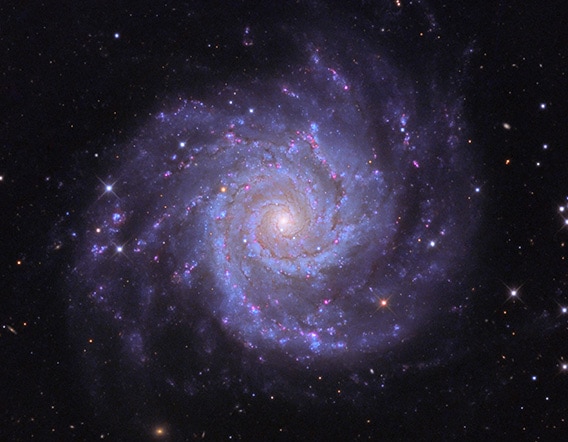Create a free profile to get unlimited access to exclusive videos, sweepstakes, and more!
The Stunning Beauty of the Perfect Spiral Galaxy M74

Q) Why should never ask for directions from an astronomer?
A) Because we think 300,000,000,000,000,000,000 kilometers is ânearbyâ.
Itâs really true. Case in point: the nearby face-on spiral galaxy M74:
I know, right? Itâs gorgeous! And at 32 million light years away, itâs actually fairly close as galaxies go. There are many closer, but few displayed so wonderfully for us to see.
I love spiral galaxies. Itâs a combination of their symmetry, the pattern, the colors, and the simple majestic beauty. M74 is an example of all of these characteristics. It has a simple 2-armed structure, each apparently unwinding from the center, splaying out at the galaxyâs edge. There are numerous spurs; short straight branches which stick out from the main arms. These add to the pinwheel-like look of the galaxy, too.
In this picture, taken by friend-of-the-BA-blog Adam Block using the 0.8 meter (32â) Schulman Telescope (RCOS) on Mt. Lemmon in Arizona, you can see the overall blue color of hot, young, massive stars, their fierce light dominating, even though by number they are only a tiny fraction of the 100 billion or so stars in M74âfainter stars are far more numerous, but their light is feeble compared to the blue powerhouses.
You can also see the reddish-pink glow of gas tracing the arms, where new stars are being born and lighting the gas up. Hydrogen in those clouds emits light in the red part of the spectrum, so even from 300 quintillion kilometers away, itâs easy to pick out where the stellar nurseries are.
Thereâs lots of dust in the galaxy, too; molecules of various dark materials created when stars are born, and also when they die. They block the visible light emitted by the stars and gas, leaving dark lanes behind. If you look in the infrared, like in the Spitzer Space Telescope image inset here, the dust itself glows, and you can see the dust follows the spiral arm structure closely, too.
I have to hand it to Adam. M74 is such a classic spiral that itâs observed by every major telescope, including Hubble. With that âscope, immense amounts of detail can be seen, but the galaxy is so big you can only view one part of it. In Adamâs picture we get the overview, standing back, so to speak, and take in the whole sight. Our gaze can lovingly linger over the entire system, letting us marvel that the Universe displays extraordinary beauty on a scale that staggers the mindâ¦even when itâs nearby.


























